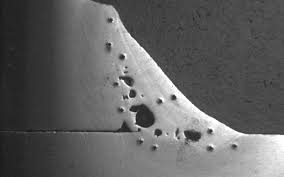Unwinding the Enigma of Porosity in Welding: Tips for Minimizing Problems and Maximizing Quality
In the intricate world of welding, porosity continues to be a relentless obstacle that can dramatically affect the high quality and integrity of bonded joints. As we dive right into the depths of porosity in welding, uncovering the keys to its avoidance and control will be critical for professionals looking for to understand the art of top notch weldments.
Comprehending Porosity in Welding
Porosity in welding, a common concern run into by welders, refers to the presence of gas pockets or gaps in the welded product, which can jeopardize the integrity and top quality of the weld. These gas pockets are normally caught throughout the welding process due to different elements such as inappropriate protecting gas, polluted base products, or inaccurate welding parameters. The formation of porosity can deteriorate the weld, making it vulnerable to fracturing and rust, inevitably causing architectural failings.
By identifying the value of keeping correct gas securing, ensuring the cleanliness of base materials, and optimizing welding settings, welders can significantly reduce the likelihood of porosity formation. Generally, an extensive understanding of porosity in welding is essential for welders to produce top quality and durable welds.

Typical Root Causes Of Porosity
When evaluating welding processes for possible quality concerns, understanding the typical reasons of porosity is vital for keeping weld integrity and protecting against structural failures. Porosity, identified by the presence of dental caries or gaps in the weld metal, can substantially compromise the mechanical residential properties of a bonded joint.
Another common root cause of porosity is the visibility of moisture and pollutants on the surface area of the base steel or filler material. When welding materials are not appropriately cleansed or are revealed to high levels of humidity, the vaporization of these pollutants throughout welding can develop gaps within the weld grain. Additionally, welding at incorrect specifications, such as exceedingly high traveling rates or currents, can create too much turbulence in the weld pool, capturing gases and causing porosity. By dealing with these common causes with appropriate gas protecting, product preparation, and adherence to ideal welding specifications, welders can lessen porosity and improve the top quality of their welds.
Strategies for Porosity Prevention
Executing effective precautionary actions is crucial in decreasing the event of porosity in welding processes. One technique for porosity avoidance is making sure appropriate cleaning of the base steel before welding. Impurities such as oil, oil, rust, and paint can bring about porosity, so detailed cleaning using ideal solvents or mechanical techniques is important.

Utilizing high-grade filler materials and protecting gases that are ideal for the base steel and welding process can substantially lower the risk of porosity. Furthermore, preserving correct welding parameters, such as voltage, present, travel rate, and gas circulation price, is vital for porosity prevention.
Moreover, using correct welding strategies, such as maintaining a consistent travel speed, electrode angle, and arc length, can assist stop porosity (What is Porosity). Appropriate training of welders to guarantee they adhere to ideal techniques and quality assurance procedures you could try here is also important in lessening porosity flaws in welding

Best Practices for Quality Welds
One secret technique is preserving proper tidiness in the welding area. Completely cleaning the workpiece and bordering location prior to welding can assist minimize these problems.
Another best technique is to carefully select the appropriate welding parameters for the specific products being signed up with. Correct criterion choice makes sure ideal weld penetration, fusion, and overall top quality. Making use of high-grade welding consumables, such as electrodes and filler steels, can substantially impact the last weld top quality.
Value of Porosity Control
Porosity control plays a critical function in guaranteeing the integrity and top quality of welding joints. Porosity, identified by the existence of cavities or gaps within the weld steel, can considerably compromise the mechanical properties and architectural stability of the weld. Excessive porosity deteriorates the weld, making it much more susceptible to fracturing, rust, and overall failing under operational tons.
Reliable porosity control is vital for keeping the desired mechanical buildings, such as strength, ductility, and durability, of the bonded joint. What is Porosity. By reducing porosity, welders can improve the total quality and dependability of the weld, making sure that it fulfills the performance demands of the designated application
In addition, porosity control is essential for achieving the desired aesthetic appearance of the weld. Extreme porosity not only damages the weld yet also interferes with its aesthetic appeal, which can be critical in industries where appearances are important. Proper porosity control methods, such as utilizing the right browse around this site securing gas, regulating the welding specifications, and making certain correct sanitation of the base products, are essential for producing top quality welds with minimal defects.

Conclusion
To conclude, porosity in welding is an usual issue that can jeopardize the high quality of the weld. By understanding the sources of porosity and applying correct prevention techniques, welders can decrease issues and accomplish higher top quality welds. article source It is important to manage porosity in welding to guarantee the integrity and toughness of the end product. Carrying out best techniques for porosity control is vital for accomplishing optimum welding outcomes.